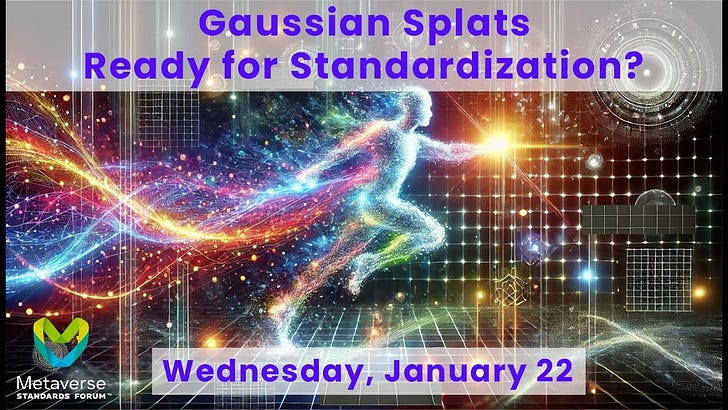Hi Everyone!
Contained in this month’s update:
Exciting updates to platforms and general industry news.
What companies are hiring for Radiance Fields, right now!
Code releases for you to try out!
Let’s get into it!
Industry Updates
In the first newsletter of the year we have a ton of exciting updates.
Brush, the platform that lets you train 3DGS on any platform, from Mac, to AMD, to Intel, or NVIDIA received its first major update, bringing a one click download and greatly expanded functionalities.
My Co-host on the View Dependent Podcast, Mr.NeRF has been posting some astonishing progress on his dynamic pipeline. VRAM usage continues to plummet in dynamic reconstructions.
We got a sneak peak into some of the preeminent reconstruction companies, such as Bentley Systems, Hexagon, Microsoft, and Meta at the Metaverse Standards Forum meeting.
NVIDIA also announced they will open source both 3D Gaussian Ray Tracing (this is not Gaussian Splatting) and 3D Gaussian Unscented Transform. These papers are both big deals and I hope that NVIDIA will release them, soon.
Instant-NGP creator, Thomas Müller, quietly added Blackwell and DLSS 4 support to Instant-NGP. While I don’t have access to the newest generation of cards, I will be curious to see how DLSS 4 affects NeRF rendering rates. I would pay very close attention to neural rendering capabilities over the course of this year.
World Foundation Models, such as NVIDIA’s recently announced Cosmos, are beginning to shift conversation of radiance fields into the world of simulation. Last year, we spoke to AV Unicorn Wayve’s Chief Scientist about how they use Radiance Fields to power long tail simulations.
Also included at CES were two Radiance Fields that NVIDIA Co-Founder and CEO, Jensen Huang used to bring attendees into NVIDIA during his Keynote address.
Fan favorite Postshot has unleashed a flurry of continual updates, including V.5 and Blackwell support. There’s no word yet when Postshot will leave its free beta phase.
There was another exciting forum on Radiance Fields, this time it was a joint workshop from JPEG and MPEG. I was also fortunate enough to speak, alongside Eunbyung Park, Davi Lazzarotto, Yiyi Liao, and Professor Angjoo Kanazawa. The Workshop was recorded, but has not been published yet.
Spline released Spell, which generates interactive 3D objects using the Radiance Field method, Gaussian Splatting.
Nerfstudio has very quietly merged a massive PR. Nerfstudio also added an Autodesk Maya extension.
OTOY’s OctaneRender 2026.1Alpha added a path traced 3DGS support. Chaos V-Ray has added support for Cinema 4D and Houdini.
The View Dependent Podcast will resume shortly with an incredible bevy of guests. If you missed the conclusion of Season 1, we closed it speaking to Co-first author of 3D Gaussian Splatting, Bernhard Kerbl. The View Dependent Podcast is now available to stream on YouTube and all major Podcasting platforms.
Newsletter Sponsor
Odyssey is pioneering world models, the next frontier of artificial intelligence. By learning from the real-world, Odyssey is training a new kind of generative model, capable of generating cinematic, interactive worlds in real-time. Odyssey’s mission is to reinvent film, gaming, and beyond.
Research
StructuredField: Unifying Structured Geometry and Radiance Field
LinPrim: Linear Primitives for Differentiable Volumetric Rendering
Relightable Full-body Gaussian Codec Avatars
HAC++: Towards 100X Compression of 3D Gaussian Splatting
RaySplats: Ray Tracing based Gaussian Splatting
Who’s Hiring:
The Job Board on Radiancefields.com is live. If you have an opening, get in touch! We are beginning to offer placement services, at no cost to you. Send us your resume from this page if you’d like to enroll!
Sony is looking for a Intern, Applied Research.
AMD is looking for a AI/ML Compiler Development Engineer.
EagleView is looking for a Research Engineer I.
Meta Reality Labs is looking for a Codec Avatars Research Scientist.
Apple is looking for a Machine Learning/Neural Rendering Algorithm Engineer.
Code releases:
Wonderland: Navigating 3D Scenes from a Single Image
Clear-Plenoxels: Floaters free radiance fields without neural networks
HAC++: Towards 100X Compression of 3D Gaussian Splatting
View-consistent 3D Editing with Gaussian Splatting
DiffSplat: Repurposing Image Diffusion Models for Scalable 3D Gaussian Splat Generation
Don’t Splat your Gaussians: Volumetric Ray-Traced Primitives for Modeling and Rendering Scattering and Emissive Media
If you found value in today’s newsletter, please consider upgrading to a paid subscription. There is currently no better way to support me and it tremendously helps to continue to provide content and information.
That’s it for this one. Please feel free to reach out for anything and see you next time!
Michael Rubloff




